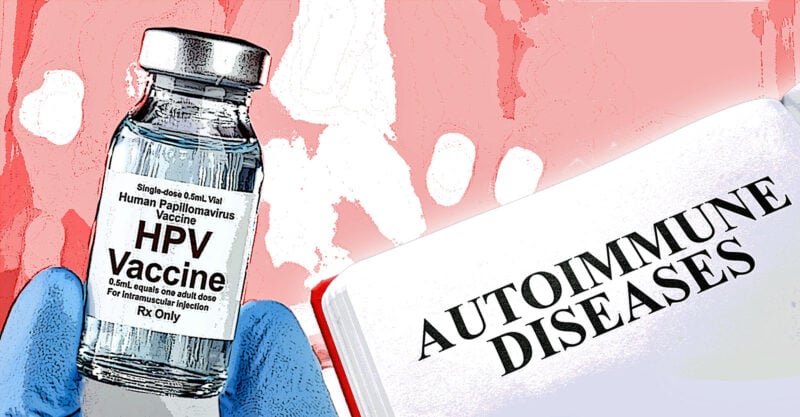Miss a day, miss a lot. Subscribe to The Defender's Top News of the Day. It's free.
A type of human papillomavirus (HPV) vaccine widely used throughout the world, but not in the U.S., may increase the risk of developing four autoimmune disorders, according to a study published last week in Vaccine.
The Colombian retrospective cohort study compared the health records of nearly 2 million vaccinated and unvaccinated adolescent girls over 10 years and found the girls vaccinated with a quadrivalent HPV vaccine were 4.4 times more likely than their unvaccinated counterparts to develop rheumatoid arthritis.
Quadrivalent HPV vaccines target four high-risk strains of HPV, compared with Merck’s Gardasil 9 vaccine, the only HPV vaccine distributed in the U.S., which targets nine strains.
Merck does make a quadrivalent Gardasil vaccine — one of two quadrivalent vaccines licensed by the World Health Organization. The study did not specify the brand of vaccine administered.
The girls in the Colombian study also were 2.76 times more likely to develop juvenile idiopathic arthritis, 2.86 times more likely to develop thyrotoxicosis and 2.54 times more likely to develop idiopathic thrombocytopenic purpura during the 180- and 360-day post-vaccination follow-up period studied.
“There are significantly higher levels of these four autoimmune disorders — in girls who weren’t diagnosed with the disorders before vaccination — in the vaccinated group,” Brian Hooker, Ph.D., chief scientific officer for Children’s Health Defense (CHD) told The Defender.
“This is a stunning admission of the immune dysregulation caused by this vaccine,” Hooker said. “At a minimum, this deserves more comprehensive investigation towards a decision whether to pull the vaccine entirely.”
The study adds to a large body of peer-reviewed scientific literature from the U.S., Australia, Denmark and Sweden, France, Japan, and Colombia and statistics published by public health agencies in each of these countries demonstrating associations between HPV vaccination and autoimmune conditions.
HPV vaccination rates in Colombia are extremely low, the authors reported. This is in part because, in 2014, 500 girls in a small town called Carmen de Bolivar reported adverse symptoms, including headache, paresthesia, shortness of breath, chest pain and fainting. Videos of the girls were widely shared on the internet.
As public confidence in the vaccine plummeted, rates went from 80% of girls in 2012 to 14% and 5% for the first and second doses in 2016. A later study classified the response as a “mass psychogenic response” unrelated to the content of the vaccine.
“There is strong scientific evidence worldwide,” the study’s authors wrote, defining the quadrivalent vaccine as “safe and effective.” However, they added, there is a lack of local studies to support that evidence. With this study, they said they hoped to provide information on the safety profile of the vaccine.
Merck’s quadrivalent Gardasil vaccine is the only quadrivalent vaccine licensed by the World Health Organization. The study did not specify the brand of vaccine administered.
As part of its commitment to catalyze national and global momentum “to eliminate cervical cancer,” Colombia hosted the first Global Cervical Cancer Elimination Forum earlier this Month in Cartagena de Indias.
The Bill & Melinda Gates Foundation, UNICEF and the World Bank committed nearly $600 million to expand global vaccination, screening and treatment in multiple countries, including Colombia.
The results ‘speak for themselves’
For their analysis, the researchers accessed national vaccination data and national health record data for adolescent girls ages 9-19 who had accessed the Colombian national healthcare system between 2012 and 2021 for 1 of 33 autoimmune, neurological and hematological diseases thought to be associated with the quadrivalent HPV vaccine and three diseases not thought to be related.
They selected 16 of the diseases most commonly associated with the HPV vaccine and used statistical analysis to compare the risk of developing each of the diseases between the vaccinated and non-vaccinated cohorts at 180 and 360 days post-vaccination.
The researchers analyzed the results from the first and second doses of the HPV vaccine separately. For the first dose, they compared 55,114 vaccinated adolescent girls to 370,800 unvaccinated ones. For the second dose, they compared 35,801 vaccinated girls to 370,793 unvaccinated ones.
For six of the diseases, they found there were not enough cases present to estimate a causal effect. Those included Guillain-Barré syndrome, transverse myelitis, optic neuritis, myasthenia gravis, multiple sclerosis, and disseminated acute encephalitis.
That left them with data for 10 diseases, including rheumatoid arthritis, juvenile idiopathic arthritis, systemic lupus erythematosus, Bell’s palsy, idiopathic thrombocytopenic purpura, thyrotoxicosis, Hashimoto’s thyroiditis, hypothyroidism, other hypothyroidismc and Type 1 diabetes.
They analyzed the causal relationship between the vaccines and those diseases over time, following the vaccinated subjects for an observational period of up to 2,000 days.
The study found significantly higher odds ratios for four of the diseases — rheumatoid arthritis, idiopathic arthritis, thyrotoxicosis and thrombocytopenic purpura — indicating that the vaccine played a role in the development of the diseases.
However, the researchers concluded that the temporal distribution of cases did not reveal a clear difference between the vaccinated and unvaccinated groups, because the rate of appearance of the new cases increased linearly for both groups — although they noted the number of cases was consistently higher in the vaccinated cohort.
They said their results should be interpreted with caution and called for further research.
Commenting on that conclusion, Hooker said, “It’s odd yet not unpredictable that the authors point out no temporal association with the vaccination date as a way to almost dismiss the biological plausibility of the significant connection.”
“However, without any type of biological mechanism of disease development in these patients, we simply don’t know what such a temporal relationship with the vaccine would be,” he added. “In other words, these significant odds ratios speak for themselves.”









